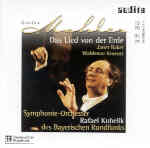Rafael Kubelik never made a studio recording of Das Lied von der Erde, but even if he had I doubt it would have been better than this simply stunning performance taken from a live concert on February 27, 1970. First, there’s no need to make allowances for the sound: the engineers have captured an amazingly realistic and well balanced picture of both singers and orchestra, with every word perfectly clear and the voices well integrated into the musical texture. Few studio recordings enjoy such success. The audience remains on best behavior throughout, extremely quiet and attentive–and no wonder!
Janet Baker recorded this piece several times, most notably with Bernard Haitink on Philips, a performance that still impresses as perhaps the best all-around recommendation in this work. She’s in even better form here, the voice noticeably younger and fresher, her response to the text every bit as keen. Her ability to spit out the words in the wild central interlude of “Von der Schönheit” is as amazing as the purity and simplicity of those “without expression” recitatives in “Der Abschied”. And how her tone opens out, like a blooming flower, in the same song’s rapturous climaxes (or at the single lyrical effusion at the close of “Der Einsame im Herbst”)!
In Waldemar Kmentt we at last have a tenor who isn’t marking time until the contralto gets to sing. He and Kubelik turn in a positively gut-wrenching account of their first song. Listen to the sexy decadence he brings to his chilling refrain, “Dark is life, is death”, and to the positively suicidal intensity he and Kubelik wring out of the movement’s climax (with a perfectly placed downward vocal slide on the word “Lebens”). Fritz Wunderlich may have sung this music more beautifully, but certainly not more dramatically. Kmentt lightens his tone adroitly for “Von der Jugend”, and just listen to how he lingers longingly over the coming of spring in his last song.
And then there’s Kubelik–a very great conductor, no doubt about it, and this performance illustrates exactly why. First, he takes great pains to get the details right. For example, notice how he allows us to hear the downward oboe glissandos after Baker sings “das Gluck nicht hold!” (at figure 52), and how this simple device adds to the passage’s tone of lamentation and bitterness. Or take the first entrance of the mandolin at figure 23. Mahler writes the part in dotted quarter-notes (and later dotted halves) in moderate 3/4 time. Obviously, the “plink” of the mandolin will not last that duration, so Kubelik has his performer play the notes tremolo. There is precedent for this: mandolin players automatically use tremolo on long notes, and some controversy has grown up about Mahler’s writing for the instrument in the Seventh Symphony for just that reason, as each conductor must decide when to add tremolo and when to “play it straight”. Kubelik’s solution, unique though it is in this particular work, makes perfect musical sense and is entirely consistent with Mahler’s notation.
But there’s more to Kubelik’s vision of the music than observance of tiny details. He understands the larger structural issues as well. Take the passage in “Abschied” after Baker sings “…warum es müsste sein” (figure 49), which Kubelik plays accelerando, making a ritard before the voice re-enters with “Er sprach…” He has noticed that this passage represents a recapitulation of the similar music at figure 5 near the song’s beginning, which Mahler marks “poco accelerando”. And so his treatment enhances the music’s sense of Mahler bringing together all of this vast movement’s diverse strands before the final peroration. From the screaming winds at the climax of the great funeral march interlude to the bubbling Chinoiserie of “Von der Jugend”, hardly a moment passes that doesn’t sound freshly imagined and characterfully realized.
These are only a few examples of Kubelik’s intense engagement with every aspect of this remarkable work, but multiply insights of this sort across the piece’s entire span and I think you’ll agree that we have something very special here. The Bavarian Radio Symphony Orchestra must have sensed this too, for it offers playing equally rich in artistry and inspiration, with no significant slips or mishaps at any point. Just listening to the care with which the horns and winds articulate their oft-repeated rhythmic motto in “Der Abschied”–Kubelik’s ideally chosen tempo (a hair slower than usual) permitting just the right sort of staccato, the decrescendo hairpins perfectly judged–reveals this to be a performance of unusual stature and vision. In short, in a work that doesn’t lack for excellent recordings this one stands among the best, and I won’t argue with anyone who comes away from this performance convinced that there are none better. [10/19/2003]
































